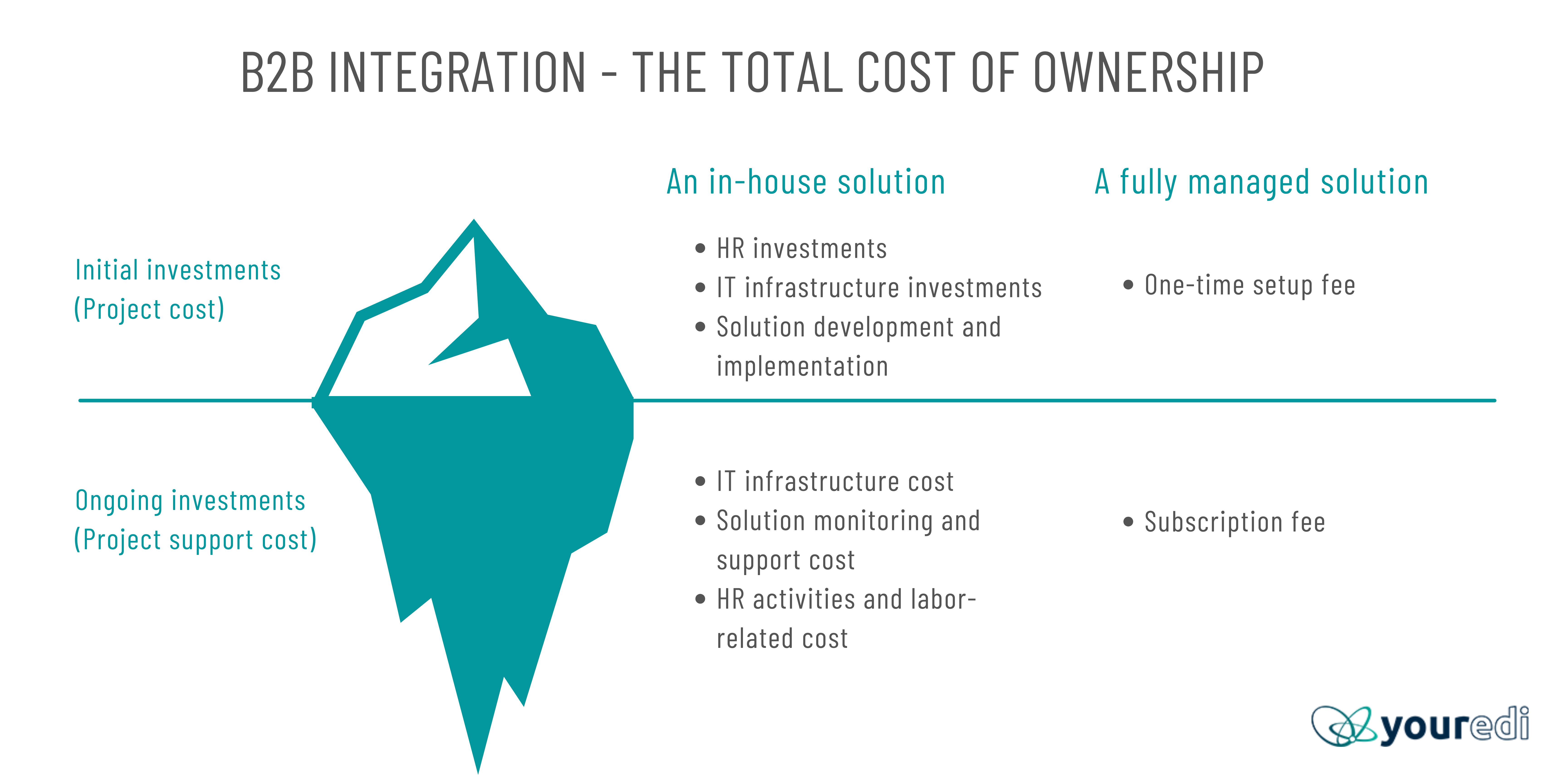It is no secret that today, customer expectations for better service are constantly rising. To ensure positive experiences for customers, more and more actors like vendors, suppliers, and distribution partners should be involved in business processes. This results in a steady increase in the complexity of supply chains.
To speed up data exchange, and to ensure full visibility and control throughout the supply chain, enterprises must adopt integration solutions that allow them to connect and collaborate with trading partners electronically.
Companies often decide which solutions they will employ based on the initial investment or purchase price, overlooking the total cost of ownership. Sooner or later, this approach will result in unpleasant surprises. Perhaps the most detrimental of which is unplanned budget spending, or a lack of resources needed to maintain the solution over its lifetime.
This article will explain why the total cost of ownership (TCO) should not be neglected when choosing a solution for your b2b messaging and why an “expensive” fully managed integration service will better assist your project in the long run.
What is TCO, and why is it important to understand the cost structure for your upcoming integration project?
The total cost of ownership, or TCO, reflects the lifetime costs associated with owning a particular asset. For a data integration solution, the TCO will consist of two parts - an initial investment needed to initiate the integration project (purchase price of infrastructure or a solution plus costs associated with deployment and implementation), and operational costs (the solution maintenance, hardware and software upgrades, and HR management costs) typically taking place over the course of five to ten years.
To better understand the cost structure of a data integration project and understand why knowing TCO is so critical, let’s look at a simplified b2b data integration case and try to outline the breakdown of costs associated with it.
Let’s assume we have a company A that needs to exchange b2b data daily with its trading partner company B. Each company has its own data standard and never worked with each other before. The existing IT team at company A barely copes with the current workload and lacks the needed integration experience. In this instance, the scope of work will be as follows.
- Company A needs to extract data from its system
- Convert the data to a format acceptable for system B
- Transmit the data instantly or by request to system B
- Receive the data back from system B when needed
- Convert the returned data into a data format digestible for system A
- And load the data back to system A.
To execute such a project, company A needs to have all the necessary IT infrastructure and an IT (or devoted integration) team capable of effectively completing the work. When both are in place, the company can start solution development. When complete, note that development time depends on a project’s complexity and the skill of those responsible for integrating it, it is time to proceed with the implementation phase. All that remains is for the company to enjoy the benefits expected from the project.
At this point, it might seem that the work is done, and that IT infrastructure, an integration team, and time investments are all what company A needs for this case. However, in fact, it is just the beginning of this project. In the world of b2b communications, nothing is static. That means you always should expect some changes from your trading partner’s end. E.g., protocol, data format, or amount of data might require adjustments from time to time.
Not to mention potential errors, possible implementation flaws, and network or even system crashes that usually happen quite unexpectedly. So, companies that do not have skilled IT staff, who constantly monitor b2b messaging between partners, may encounter significant troubles. That means, besides an integration team, company A also needs support or even a crisis management team.
Apart from that, almost any integration project requires regular software and hardware updates, maintenance, and support. Plus, there always will be HR-related costs needed for personnel training and retaining activities. All of these create additional costs that companies must bear in mind when planning the budget and choosing an integration solution.
Based on this example, we can distinguish two groups of costs - initial investments (project cost) and ongoing investments (project support cost). For each group, we can outline the main factors that affect TCO for most b2b integration projects.
1. Initial Investments (Project Costs)- HR investments: Hiring, training, and retaining an integration team
- IT infrastructure investments: Planning and Purchasing Software and Hardware (cloud infrastructure in some cases)
- Solution development and implementation (Human Labor and Time):
- Solution development
- Setting up, configuring, and testing a developed solution.
- Data migration/data access from legacy solutions
- IT infrastructure costs: Software or cloud licensing fees; hardware maintenance and updates. Hardware-related expenses such as electricity, cooling, floor or rack space, security, support, and management
- Solution monitoring and support costs: Planning and change management (e.g., scaling a business requires new trading partner onboarding or adjustments of existing setup), disaster recovery program
- HR cost: Labor cost, personnel training and retaining activities, and ongoing management of integration team (growth/reduction based on company growth)
The TCO breakdown can be characterized as an iceberg, where the visible elements represent the amount companies are paying to initiate the project, and those areas beneath the surface indicate hidden costs vital to its continued progression.
Often, when companies plan budget allocation for b2b integrations, many focus on the tip of the iceberg and overlook the ongoing costs that usually represent the most significant part of TCO. In most cases, this will lead to poor decisions regarding the integration solution and increase the chance of project failure.
While comparing integration options, companies should always consider all the factors affecting TCO. Otherwise, the assessment will be incorrect, and the planned budget will be insufficient to sustain the project.
"Expensive" fully managed integration services might be way cheaper than doing integration in-house
When it comes to b2b integration, all existing solutions can be delivered as software, cloud infrastructure, or even fully managed services (also known as fully managed data integration solutions). In most instances, the first two options are executed as in-house projects (a business relies on its own capabilities and manages all integration responsibilities internally). Fully managed data integration services, on the other hand, typically imply that a business outsources all the integration tasks to an integration partner, whose team of experts executes and maintains the project on the customer's behalf. Understood this way, a fully managed service can be viewed as a partnership between a company and an integration partner, who takes care of your integration needs, and who completes obligations ranging from design, deployment, and maintenance.
Although the purpose of all integration solutions is always the same - to ensure smooth data exchange between trading partners - each type of integration implies a different level of involvement in terms of risk-taking and investments needed.
With fully managed integrations, the burden of solution ownership falls totally on a vendor providing this service. As a result, for a client using this service, the cost structure will have only two variables - an initial set-up fee and subscription fee, where the latter often depends on the usage of the service. A business conducting in-house integrations will take full responsibility for solution ownership, making the TCO structure more complex and increasing the likelihood of investment planning mistakes. The diagram below explicitly shows the difference between the two approaches in terms of TCO.

With the in-house method, the risk of underestimating costs, like personnel workload and operational expenses, is always high, especially if a company has no experience in integrations. Managed integrations, on the other hand, experience no such issue.
To speed up integration projects, and to mitigate the risks and costs that are associated with them (lack of skills, software, or even hardware-related issues), companies often prefer to outsource their integrations, or, perhaps more appropriately, execute them with the assistance of a fully managed data integration service.
These services are particularly useful for companies that seek b2b integration solutions that can scale easily and provide a transparent and predictable cost structure. Another important advantage managed services provide is time to market, an element that demonstrates how quickly you can onboard new partners and start working with them. Leveraging a fully managed service, a company can expect 5-10 times faster results than with an in-house approach, not only affecting the costs associated with an integration project but also its projected revenue.
Since TCO assessment is not an easy task, and many companies often miss additional costs within their calculations, the price difference between in-house and outsource models may, at first sight, be frightening. However, since all aforementioned factors directly affect the TCO of the solution in question, and cannot be removed from the equation, fully managed solutions are way more efficient and economically feasible in the long run.
Conclusion
Choosing the right data integrations solution is crucial for your business. To ensure your decision is informed, you must understand each factor in the TCO structure. In real life, the b2b environment is more complex than the aforementioned example, therefore, the “true” TCO calculation might comprise several additional factors that may impact overall costs. A completely accurate assessment that considers all of the cost components associated with each stage of your integration project may be more challenging, even impossible if your team lacks experience in the field. The Youredi team can help you with this exercise, equipping you with the data you need to make the right choice and mitigate the risk of failure for your integration project.
If you have questions or data integration challenges that you need help with, please contact us via this form or book a free meeting with our integration architect.


